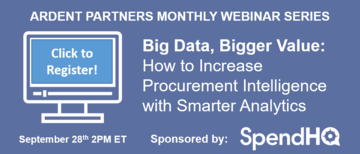The path to true “spend enlightenment” is not merely paved with standard spend analysis. In fact, those organizations seeking to adopt next-generation spend analysis strategies must adapt to a changing mindset that involves integration, collaboration, and a reliance on (and comfort with) data-driven approaches for spend and supplier management.
How can today’s information be transformed into the intelligence and strategies that drive tomorrow’s activity and results? First, enterprises must begin to incorporate internally-generated supplier performance data/information and external, third-party data to enhance the core spend data that exists within a typical spend analysis solution today. Information and other data regarding supplier news, legal, and regulatory concerns or status, and many other key issues (some were outlined in the section above) can be co-located with spend data and supplier performance results to present a 360-degree view of suppliers. By aggregating and mining this broad set of relevant data, enterprises will surely be afforded with more actionable intelligence, not to mention that procurement can evolve into a more valuable resource and internal partner.
Next, the force-multiplier effect of sharing this data with different stakeholders and constituencies can help harness and focus the collective enterprise’s expertise and resources on the biggest opportunities or threats. For example, the accounts payable team can give insight into the quality and depth of invoices (did suppliers deliver on what was promised? Was that reflected in the invoice?), while some key stakeholders can speak to the relative quality of delivered materials and services as others can identify unseen risks or advantages based upon their location, role, or expertise. A collaborative approach to information and knowledge management is vital in deepening the breadth of organizational intelligence far beyond simple spend data.
Finally, at its core, the future of spend analysis will be predictive in nature. With larger and richer data/information sample sizes, business algorithms will emerge from within the analytical tools that will help better predict shifts in market pricing so that sourcing teams can take advantage of market inefficiencies and changes or flag with a higher degree of certainty the potential for supplier risk incidents so that contingency plans can be initiated or alternative sources of supply can be established.
Conclusion
The procurement function is approaching a tipping point. Although procurement professionals often lean on traditional approaches for managing enterprise spend, it is through “next-generation” strategies and spend analysis solutions that the function’s true opportunity will be realized. Data-driven approaches founded on the principles of spend analysis, and broadened via integrated and collaborative intelligence to improve supply management, are prime means of accelerating procurement performance and ultimately driving more value. Spend analysis solutions will be the critical enablers of these data-driven strategies, providing automated, repeatable, and scalable processes that procurement teams can use to more effectively manage, use, and share key information with internal and external stakeholders and partners.
Additionally, the powerful analytics found in these spend analysis solutions will become even more important as the amount of data and the complexity in processing and analyzing it both grow exponentially. Next-gen spend intelligence will be far more robust, accurate, and timely and, as a result, will enable procurement teams to improve their internal and external collaboration, execute with greater precision, and ultimately make a bigger impact on business operations and results.
RELATED RESEARCH
If you are interested in learning more about this topic, join us Tuesday, September 28th at 2 PM ET on a new webinar, Big Data, Bigger Value: How to Increase Procurement Intelligence with Smarter Analytics.


